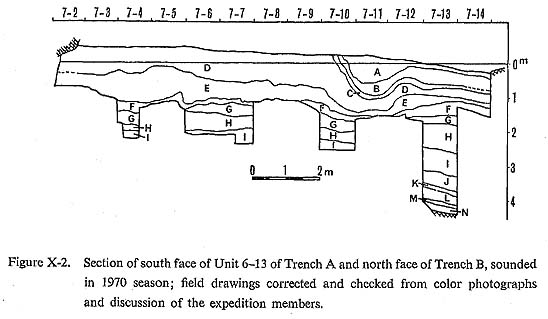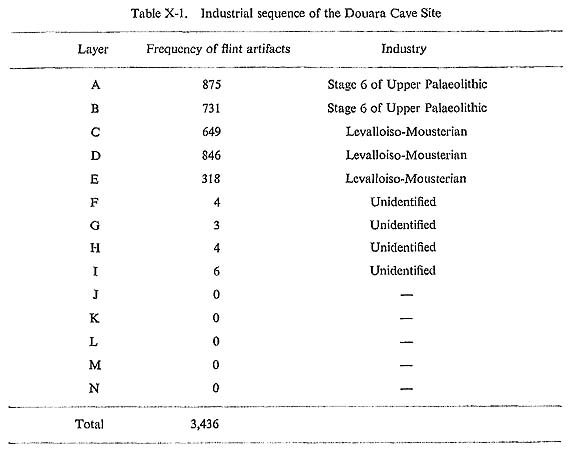CHAPTER X
PALAEOLITHIC ASSEMBLAGES FROM THE DOUARA CAVE SITE
Takeru AKAZAWA
Department of Anthropology and Prehistory, The University Museum, The University of Tokyo
| ( 1 / 7 ) |
1. INTRODUCTIONThe flint artifacts described in this chapter were excavated from the Palaeolithic site at Douara Cave in central Syria. The site was found during the third season of the Tokyo University Scientific Expedition to Western Asia in 1967, and was recorded for the first time in the report of that expedition (Suzuki and Kobori, 1970 : 36). Up to now, most studies of Palaeolithic culture in Western Asia have concentrated in the areas of the Mediterranean coast and the Jordan Valley in the Levant, and in the Zagros area. Research on the sites in inland areas is rather insufficient, and only two Palaeolithic sites, Yabrud (Rust, 1950; Solecki and Solecki, 1966) and Jerf Ajla (Coon, 1957; Schroeder, 1966, 1969), are Fully reported. Thus there is a regional difference in the quantity of information avail able, and this presents an obstacle to systematic interpretation of Palaeolithic culture in Western Asia. If we had more information from sites in the Syrian inland between the Levant and the Zagros, more comprehensive and interesting studies would be possible in comparing the data from the two areas. To that end, the Tokyo University Scientific Expedition to Western Asia has investigated the site at Douara Cave since 1967. The 1970 season's research on the Douara Cave was only a preliminary excavation to learn the nature of the deposits inside and outside of the cave and to examine the horizontal and vertical distribution of the Middle, Upper and post-Palaeolithic deposits whose existence was suggested by the flint materials collected during the 1967 season's survey (Suzuki and Kobori, 1970). The method of excavation, after removal of the recent feces layer from cave floor, was a grid system of 1 × 1 meter units. A total of 22 units were excavated in three trenches desig nated A, B and C (Fig. X-I). From the excavation of the trenches, it was found that the sequence of deposits could be divided into 14 geological layers (Layers A through N), mainly on the basis of sedimentary facies and soil color as described in Chapters II and VI(Fig. X-2). However, the complete sequence of layers was clarified only in Unit 6-13 of Trench A, a 1 × 1 meter unit, excavated to about 4.30 meters below the surface. The remaining excavated units were exposed only to a depth of 1 to 2 meters below the surface.
The preliminary excavation of the site during the 1970 season collected a great quantity of flint artifacts and other data requiring further investigation. Approximately 3,500 objects classifiable as artifacts were found from throughout the excavated areas (Table X-1). Though the sequence of deposits was divided into 14 layers, the layers producing human artifacts are limited to the upper nine layers, Layers A through I, and. the relative quantity of flint artifacts found in each layer varies considerably. Layers A through E have the richest archaeological deposits yielding a large quantity of artifacts, while the underlying Layers F through I have poor archaeological deposits, even if consideration is given to the relatively small area ex cavated in these layers.
Analysis of these flint artifacts showed that the deposits of Douara Cave contain two dis- tinct assemblages: an assemblage with a large proportion of blade and bladelet elements of Upper Palaeolithic character, found in Layers A and B, and an assemblage with a large proportion of Levallois flakes, found in Layers C, D and E. The assemblage in Layers A and B has the same characteristics, both typologically and stratigraphically, as the indus tries now well defined as the terminal stage of the Upper Palaeolithic in Western Asia. It is the same as the Kebaran industry from Layer C at the type site of Mugharet el Kebarah (Turville Petre, 1932), the Nebekian industry from Layers 7, 6 and 4 at the type site of Yabrud Shelter III (Rust, 1950) and the Zarzian industry from the type site of Zarzi (Garrod, 1930), all of which belong to the terminal stage of the Upper Palaeolithic in Western Asia. These indus tries are classified into Stage 6 in Neuville's nomenclature for Upper Palaeolithic industries in Western Asia (Neuville, 1951). The assemblages in Layers C, D and E resemble closely the industry that is identified as the Levalloiso-Mousterian or the Mousterian of Levallois facies of the Middle Palaeolithic in Western Asia. These assemblages are characterized by the dominance of the Levallois tech nique in the production of tool blanks and by Middle Palaeolithic tools of the Levallois type and of the Mousterian type such as side-scrapers. Layers F through I yielded very few implements with characteristics of Middle Palaeolithic tool types. However, these artifacts are too scarce to identify these horizons to certain indus tries already defined. This awaits further excavation of the site. With the exception of a very small collection from Layers F through I, the materials of each layer are numerous enough to compare quantitatively and qualitatively with certain industries already defined. Therefore, in the first section of this chapter, the technological and typological characteristics of the total collection from each layer are described to provide the substantial data to compare the Douara assemblages with each other-intra site comparison and with other assemblages from relevant sites-inter site comparison. In the succeeding sections, the intra site and inter site comparisons are made on the basis of the technological and typological characteristics of the assemblages described in the first section. |


